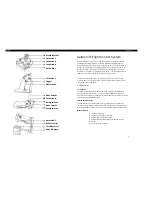
36
Service menu
Sense II – 6 720 818 367 (2015/10)
– The frost protection must be outside-temperature-
dependent and the DHW priority must be activated.
– The electrical integration of a constant heating circuit
into the system is performed via an MM 100/MM 200
module.
– The MC1 connecting terminal in the MM 100/MM 200
module must be bridged (factory-fitted) according to
the technical documentation of the module.
– The T0 temperature sensor can be connected to the
MM 100 module for the constant heating circuit.
– Further information on the connection is available in
the technical documentation of the MM 100/MM 200
module.
Set the heating system and heating curve for weather-
compensated control
▶ Set the heating emitter type (radiator, convector or
underfloor heating system) in the
Central heating
settings
>
Heating circuit 1 ... 4
>
Heating system heat
circ. 1
menu.
▶ Set the control type (weather-compensated or weather-
compensated with base point) in the
Ctrl type h. circ. 1
menu.
Menu items that are not required for the selected heating
system and control type are disabled. The settings only
apply for the selected heating circuit, if available.
Menu for setting of the heating curve
Menu item
Adjustment range
description
Design
temperature
or
End point
30 ...
75
... 85 °C
(radiator/convector)
30 ...
45
... 60 °C
(underfloor heating
system)
The design temperature is only available with weather-compensated control without
base point. The design temperature is the flow temperature that is reached when the
outside temperature is at the minimum and, thus, affects the steepness of the heating
curve.
The end point is only available with weather-compensated control with base point. The
end point is the flow temperature that is reached when the outside temperature is at the
minimum and, thus, affects the steepness of the heating curve. When the base point is
above 30 °C, the base point is the minimum value.
Base point
e.g. 20 ...
25 °C
... End point
The base point of the heating curve is only available with weather-compensated control
with a simple heating curve.
Max. flow
temperature
30 ...
75
... 85 °C
(radiator/convector)
30 ...
48
... 60 °C
(underfloor heating
system)
Maximum flow temperature
Solar influence
– 5 ... – 1 K
Within certain limits, the solar irradiation influences the weather-compensated control
(the additional heat from the sun lowers the required heat output).
Off
The solar irradiation is not considered by the control.
Room influence Off
The weather-compensated control functions independently of the room temperature.
1 ...
3
... 10 K
The difference between set room temperature and measured room temperature leads
to a parallel shift of the heating curve. The higher the set value for Room influence the
bigger is the shift of the heating curve for a given temperature difference (only available
if the controller is installed in a suitable reference room).
Room
temperature
offset
– 10 ...
0
... 10 K
Heating curve adjustment based on deviation between temperature measured at the
controller and thermometer (see section 7.6.7, page 48)
Fast heat-up
Off
No flow temperature excess at the end of a setback temperature phase
0 ... 100 %
The quick heat-up accelerates the heating-up time after a setback temperature phase.
The higher the setting value, the greater the excess of the flow temperature at the end of
a setback phase. The set building type affects the duration of the excess (
building, page 31). This setting is only available if the room influence is switched off.
Table 21 Set heating curve menu
















































